Clinical characteristics, endoscopic image of gastroesophageal reflux disease in the elderly
This study aimed to examine the clinical features and endoscope imagery of gastroesophageal reflux
disease (GERD) in the elderly. We conducted a cross - sectional study of 96 elderly patients from Bach Mai
hospital’s gastroscopy unit. 58.3% of the patients were female. The mean age was 73.12 + 8.22, with a
range from 60 - 92 years old. The majority of participants suffered from GERD for less than one year (50%).
The most common clinical symptoms were burning (67.7%), epigastric pain (63.5%) and heartburn (63.5%).
Other symptoms included persistent cough (30.2%) and dysphasia (25.0%). The most common risk factors
for GERD were being overweight or obese (40.6%) and alcohol or beer consumption (21.9%). Most of the
patients were found to have pharyngitis grade A (49.9%) or pharyngitis grade B (34.4%). Patients commonly
had accompanying gastritis symptoms. Additionally, the proportion of patients with Barrett’s esophagus was
high at 30.3%. In conclusion, popular signs of GERD in this elderly patient population included burning, epigastric pain and heartburn. Given the high percentage of patients found to have Barrett's esophagus, there
may be a need for continued monitoring of these patients with endoscopy to prevent future complications.

Trang 1
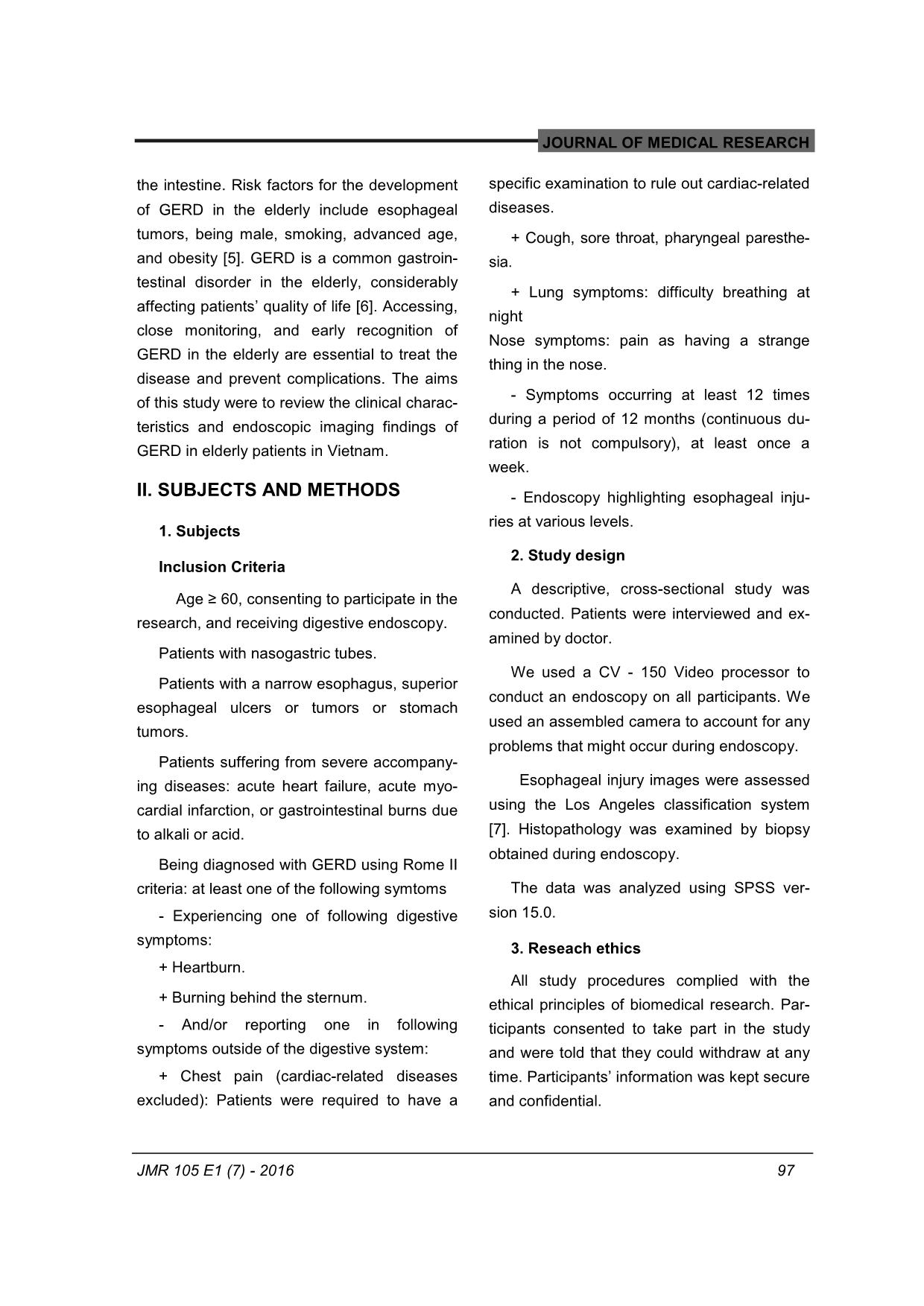
Trang 2

Trang 3
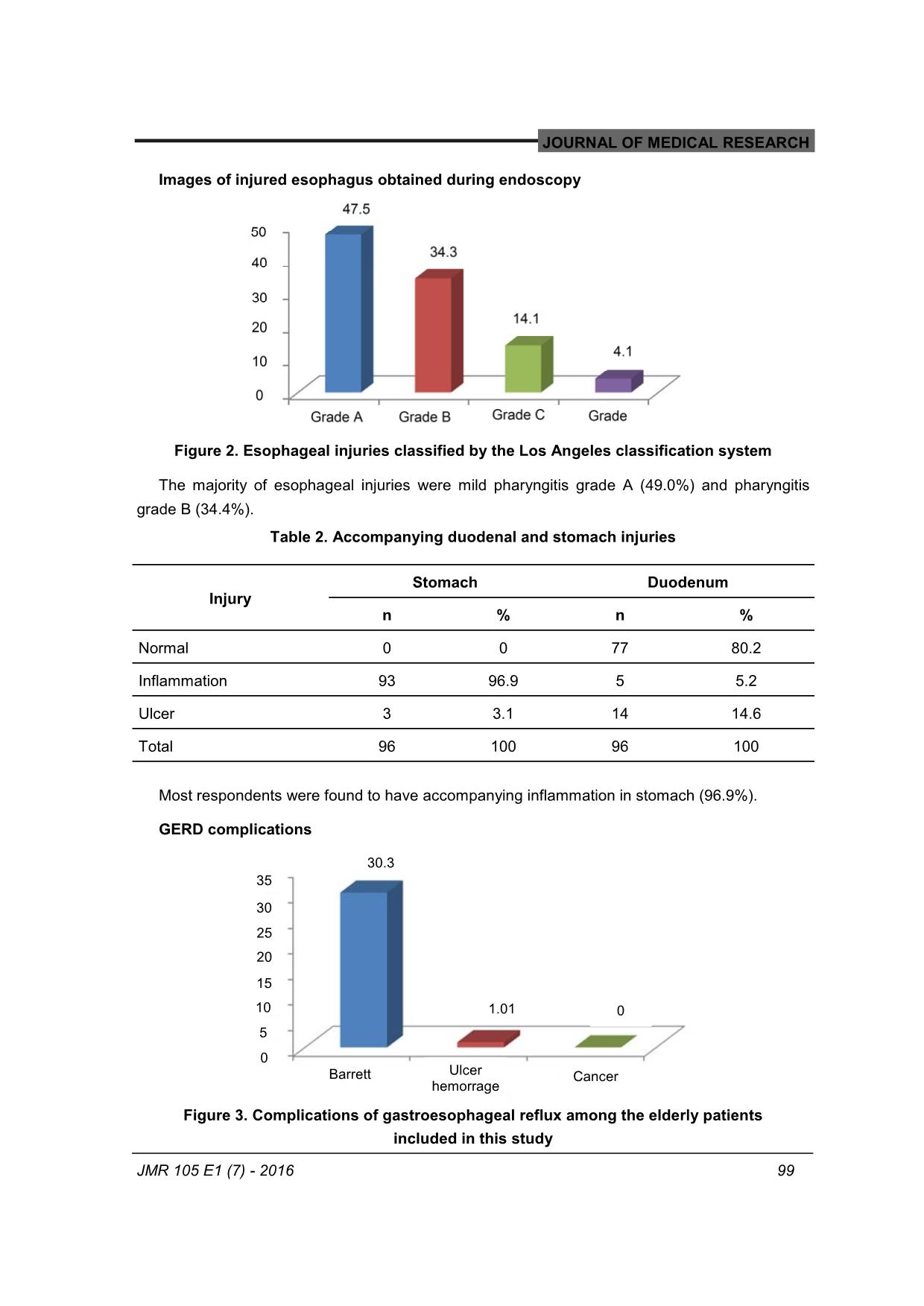
Trang 4
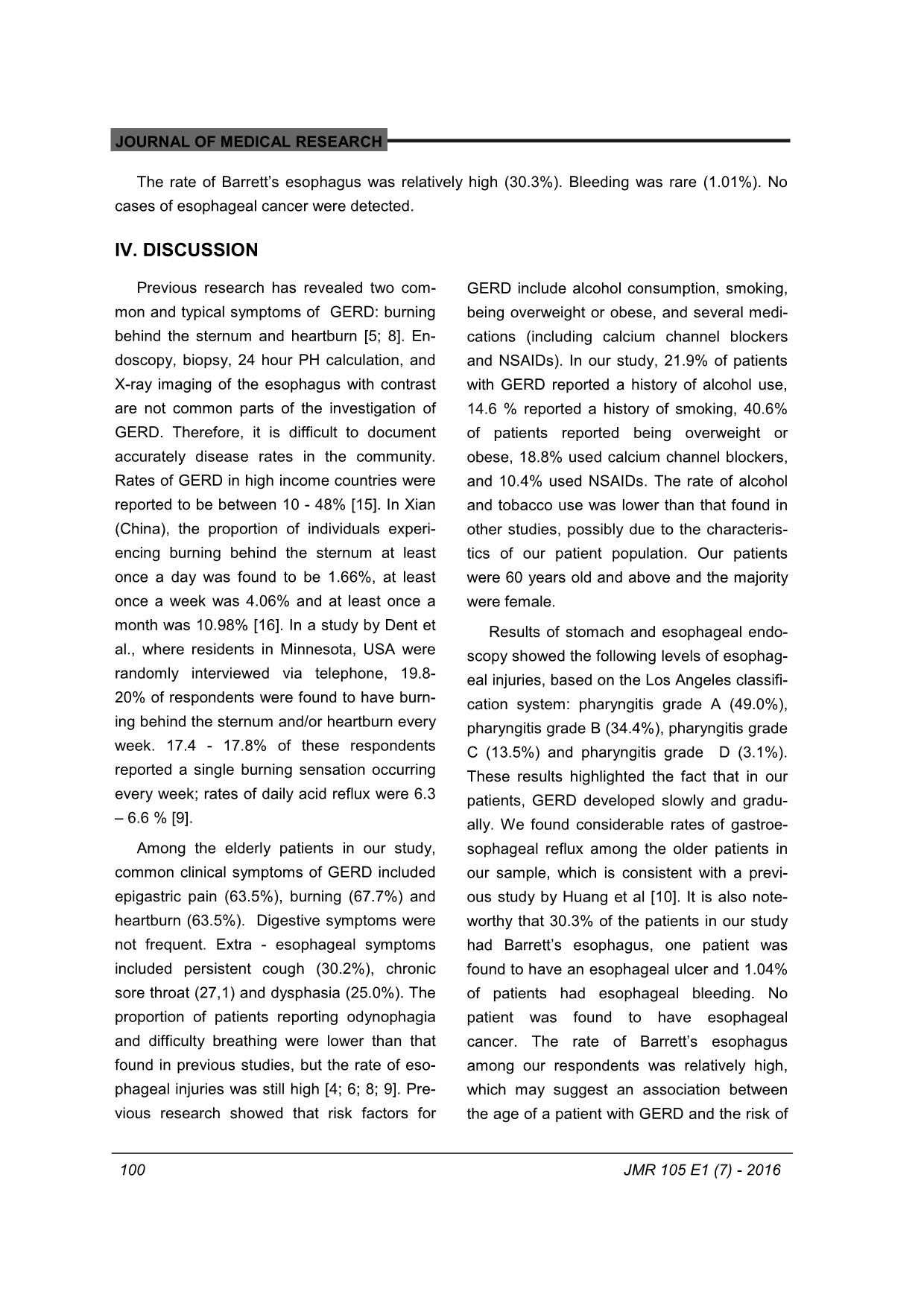
Trang 5
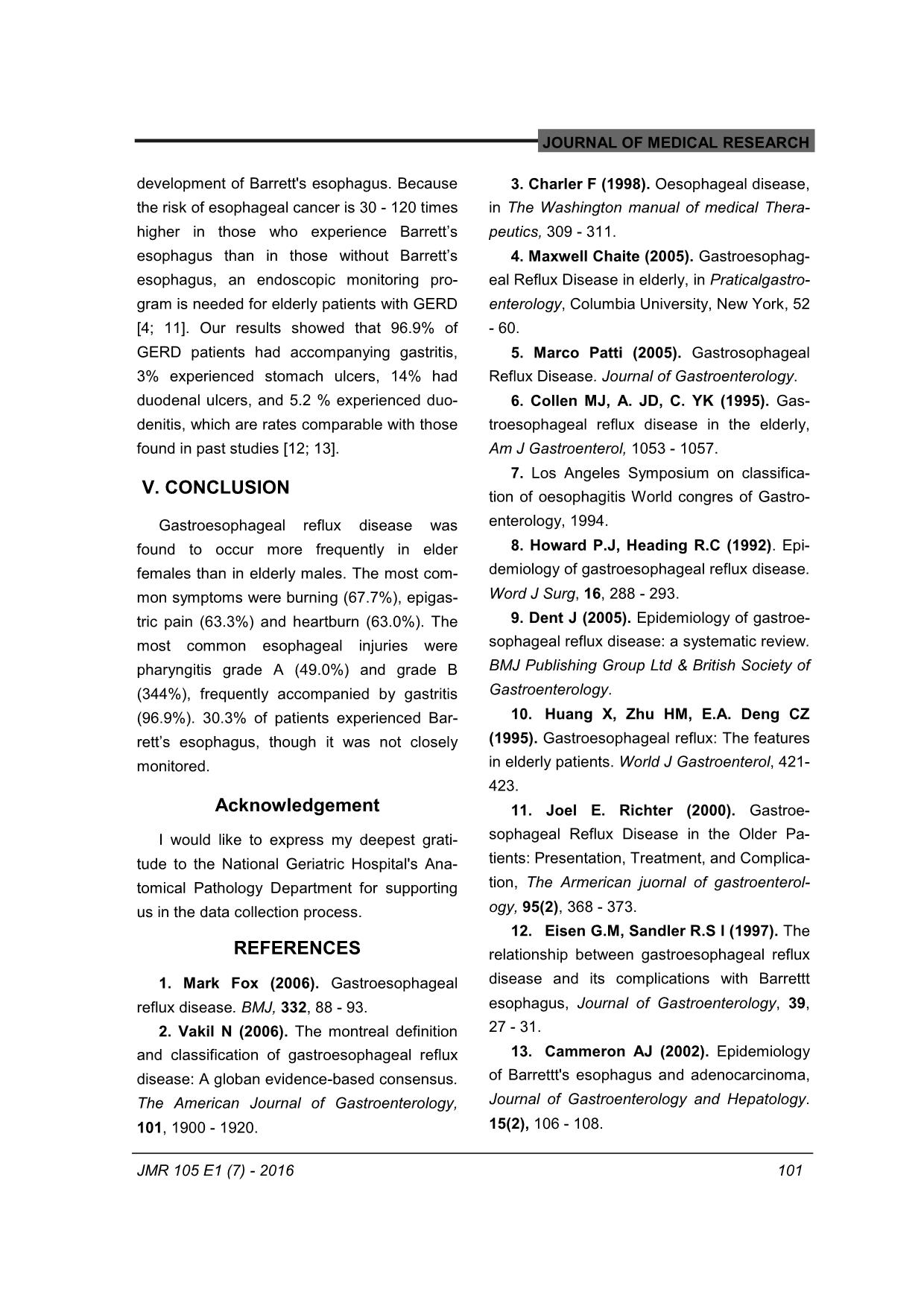
Trang 6
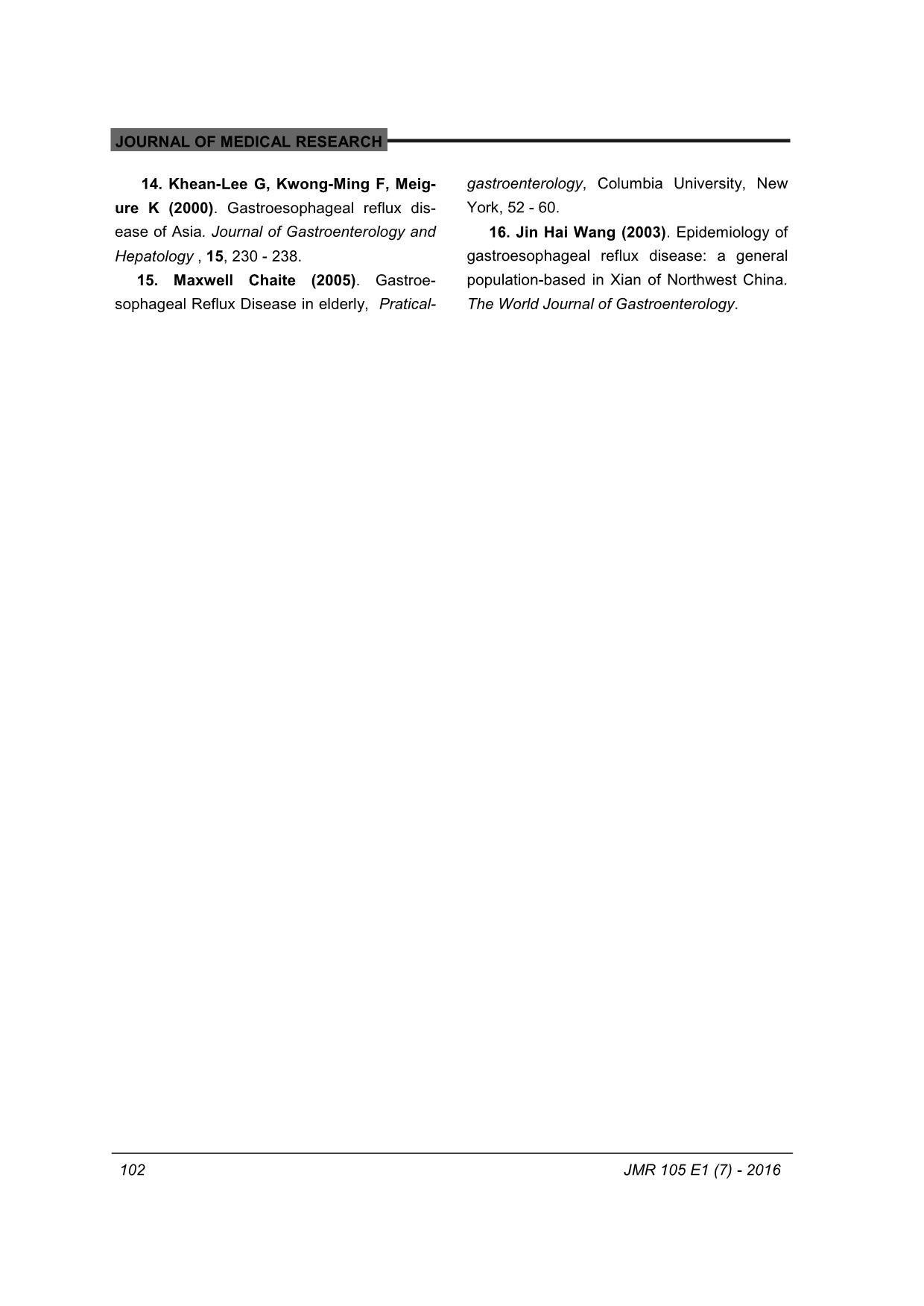
Trang 7
Tóm tắt nội dung tài liệu: Clinical characteristics, endoscopic image of gastroesophageal reflux disease in the elderly
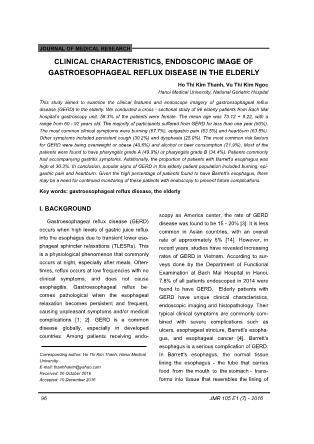
96 JMR 105 E1 (7) - 2016 JOURNAL OF MEDICAL RESEARCH CLINICAL CHARACTERISTICS, ENDOSCOPIC IMAGE OF GASTROESOPHAGEAL REFLUX DISEASE IN THE ELDERLY Ho Thi Kim Thanh, Vu Thi Kim Ngoc Hanoi Medical University, National Geriatric Hospital This study aimed to examine the clinical features and endoscope imagery of gastroesophageal reflux disease (GERD) in the elderly. We conducted a cross - sectional study of 96 elderly patients from Bach Mai hospital’s gastroscopy unit. 58.3% of the patients were female. The mean age was 73.12 + 8.22, with a range from 60 - 92 years old. The majority of participants suffered from GERD for less than one year (50%). The most common clinical symptoms were burning (67.7%), epigastric pain (63.5%) and heartburn (63.5%). Other symptoms included persistent cough (30.2%) and dysphasia (25.0%). The most common risk factors for GERD were being overweight or obese (40.6%) and alcohol or beer consumption (21.9%). Most of the patients were found to have pharyngitis grade A (49.9%) or pharyngitis grade B (34.4%). Patients commonly had accompanying gastritis symptoms. Additionally, the proportion of patients with Barrett’s esophagus was high at 30.3%. In conclusion, popular signs of GERD in this elderly patient population included burning, epi- gastric pain and heartburn. Given the high percentage of patients found to have Barrett's esophagus, there may be a need for continued monitoring of these patients with endoscopy to prevent future complications. Key words: gastroesophageal reflux disease, the elderly Corresponding author: Ho Thi Kim Thanh, Hanoi Medical University E-mail: thanhhokim@yahoo.com Received: 20 October 2016 Accepted: 10 December 2016 I. BACKGROUND Gastroesophageal reflux disease (GERD) occurs when high levels of gastric juice reflux into the esophagus due to transient lower eso- phageal sphincter relaxations (TLESRs). This is a physiological phenomenon that commonly occurs at night, especially after meals. Often- times, reflux occurs at low frequencies with no clinical symptoms, and does not cause esophagitis. Gastroesophageal reflux be- comes pathological when the esophageal relaxation becomes persistent and frequent, causing unpleasant symptoms and/or medical complications [1; 2]. GERD is a common disease globally, especially in developed countries. Among patients receiving endo- scopy an America center, the rate of GERD disease was found to be 15 - 20% [3]. It is less common in Asian countries, with an overall rate of approximately 6% [14]. However, in recent years, studies have revealed increasing rates of GERD in Vietnam. According to sur- veys done by the Department of Functional Examination at Bach Mai Hospital in Hanoi, 7.8% of all patients endoscoped in 2014 were found to have GERD. Elderly patients with GERD have unique clinical characteristics, endoscopic imaging and histopathology. Their typical clinical symptoms are commonly com- bined with severe complications such as ulcers, esophageal stricture, Barrett's esopha- gus, and esophageal cancer [4]. Barrett's esophagus is a serious complication of GERD. In Barrett's esophagus, the normal tissue lining the esophagus - the tube that carries food from the mouth to the stomach - trans- forms into tissue that resembles the lining of JMR 105 E1 (7) - 2016 97 JOURNAL OF MEDICAL RESEARCH the intestine. Risk factors for the development of GERD in the elderly include esophageal tumors, being male, smoking, advanced age, and obesity [5]. GERD is a common gastroin- testinal disorder in the elderly, considerably affecting patients’ quality of life [6]. Accessing, close monitoring, and early recognition of GERD in the elderly are essential to treat the disease and prevent complications. The aims of this study were to review the clinical charac- teristics and endoscopic imaging findings of GERD in elderly patients in Vietnam. II. SUBJECTS AND METHODS 1. Subjects Inclusion Criteria Age ≥ 60, consenting to participate in the research, and receiving digestive endoscopy. Patients with nasogastric tubes. Patients with a narrow esophagus, superior esophageal ulcers or tumors or stomach tumors. Patients suffering from severe accompany- ing diseases: acute heart failure, acute myo- cardial infarction, or gastrointestinal burns due to alkali or acid. Being diagnosed with GERD using Rome II criteria: at least one of the following symtoms - Experiencing one of following digestive symptoms: + Heartburn. + Burning behind the sternum. - And/or reporting one in following symptoms outside of the digestive system: + Chest pain (cardiac-related diseases excluded): Patients were required to have a specific examination to rule out cardiac-related diseases. + Cough, sore throat, pharyngeal paresthe- sia. + Lung symptoms: difficulty breathing at night Nose symptoms: pain as having a strange thing in the nose. - Symptoms occurring at least 12 times during a period of 12 months (continuous du- ration is not compulsory), at least once a week. - Endoscopy highlighting esophageal inju- ries at various levels. 2. Study design A descriptive, cross-sectional study was conducted. Patients were interviewed and ex- amined by doctor. We used a CV - 150 Video processor to conduct an endoscopy on all participants. We used an assembled camera to account for any problems that might occur during endoscopy. Esophageal injury images were assessed using the Los Angeles classification system [7]. Histopathology was examined by biopsy obtained during endoscopy. The data was analyzed using SPSS ver- sion 15.0. 3. Reseach ethics All study procedures complied with the ethical principles of biomedical research. Par- ticipants consented to take part in the study and were told that they could withdraw at any time. Participants’ information was kept secure and confidential. 98 JMR 105 E1 (7) - 2016 JOURNAL OF MEDICAL RESEARCH III. RESULTS A total of 96 patients participated in the study. The percentage of female patients was 58.3%. Patients’ mean age was 73.17 ± 8. 22, with a range from 60 years of age to 92 years of age. The majority of respondents had suffered from GERD for less than one year (50%). Table 1. Clinical characteristics of GERD among the elderly patients included in this study Symptoms N % Heartburn 61 63.5 Burning 65 67.7 Nausea, vomiting 24 25.0 Epigastric pain 61 63.5 Difficulty swallowing 24 25.0 Odynophagia 5 5.2 Persistent cough 29 30.2 Sorethroat 26 27.1 Difficulty breathing 3 3.1 The most common symptoms endorsed by respondents were burning (67.7%), epigastric pain (63.5%) and heartburn (63.5%). Symptoms outside of digestive system included persistent cough (30.2%) and difficulty swallowing (25.0%). Alcohol Smoking Over weight NSAIDS CCB Figure 1. Risk factors of GERD The most common risk factors for GERD were being overweight or obese (39.4%) and drink- ing beer or alcohol (21.2%). 18.2 10.1 39.4 14.1 21.2 50 25 37.5 12.5 0 JMR 105 E1 (7) - 2016 99 JOURNAL OF MEDICAL RESEARCH Images of injured esophagus obtained during endoscopy Figure 2. Esophageal injuries classified by the Los Angeles classification system The majority of esophageal injuries were mild pharyngitis grade A (49.0%) and pharyngitis grade B (34.4%). Table 2. Accompanying duodenal and stomach injuries Injury Stomach Duodenum n % n % Normal 0 0 77 80.2 Inflammation 93 96.9 5 5.2 Ulcer 3 3.1 14 14.6 Total 96 100 96 100 Most respondents were found to have accompanying inflammation in stomach (96.9%). GERD complications 4.1 34.3 47.5 GradeGrade BGrade A 50 40 30 20 10 0 0 CancerUlcer hemorrage 1.01 30.3 Barrett 35 30 25 20 15 10 5 0 Figure 3. Complications of gastroesophageal reflux among the elderly patients included in this study 14.1 Grade C 100 JMR 105 E1 (7) - 2016 JOURNAL OF MEDICAL RESEARCH The rate of Barrett’s esophagus was relatively high (30.3%). Bleeding was rare (1.01%). No cases of esophageal cancer were detected. IV. DISCUSSION Previous research has revealed two com- mon and typical symptoms of GERD: burning behind the sternum and heartburn [5; 8]. En- doscopy, biopsy, 24 hour PH calculation, and X-ray imaging of the esophagus with contrast are not common parts of the investigation of GERD. Therefore, it is difficult to document accurately disease rates in the community. Rates of GERD in high income countries were reported to be between 10 - 48% [15]. In Xian (China), the proportion of individuals experi- encing burning behind the sternum at least once a day was found to be 1.66%, at least once a week was 4.06% and at least once a month was 10.98% [16]. In a study by Dent et al., where residents in Minnesota, USA were randomly interviewed via telephone, 19.8- 20% of respondents were found to have burn- ing behind the sternum and/or heartburn every week. 17.4 - 17.8% of these respondents reported a single burning sensation occurring every week; rates of daily acid reflux were 6.3 – 6.6 % [9]. Among the elderly patients in our study, common clinical symptoms of GERD included epigastric pain (63.5%), burning (67.7%) and heartburn (63.5%). Digestive symptoms were not frequent. Extra - esophageal symptoms included persistent cough (30.2%), chronic sore throat (27,1) and dysphasia (25.0%). The proportion of patients reporting odynophagia and difficulty breathing were lower than that found in previous studies, but the rate of eso- phageal injuries was still high [4; 6; 8; 9]. Pre- vious research showed that risk factors for GERD include alcohol consumption, smoking, being overweight or obese, and several medi- cations (including calcium channel blockers and NSAIDs). In our study, 21.9% of patients with GERD reported a history of alcohol use, 14.6 % reported a history of smoking, 40.6% of patients reported being overweight or obese, 18.8% used calcium channel blockers, and 10.4% used NSAIDs. The rate of alcohol and tobacco use was lower than that found in other studies, possibly due to the characteris- tics of our patient population. Our patients were 60 years old and above and the majority were female. Results of stomach and esophageal endo- scopy showed the following levels of esophag- eal injuries, based on the Los Angeles classifi- cation system: pharyngitis grade A (49.0%), pharyngitis grade B (34.4%), pharyngitis grade C (13.5%) and pharyngitis grade D (3.1%). These results highlighted the fact that in our patients, GERD developed slowly and gradu- ally. We found considerable rates of gastroe- sophageal reflux among the older patients in our sample, which is consistent with a previ- ous study by Huang et al [10]. It is also note- worthy that 30.3% of the patients in our study had Barrett’s esophagus, one patient was found to have an esophageal ulcer and 1.04% of patients had esophageal bleeding. No patient was found to have esophageal cancer. The rate of Barrett’s esophagus among our respondents was relatively high, which may suggest an association between the age of a patient with GERD and the risk of JMR 105 E1 (7) - 2016 101 JOURNAL OF MEDICAL RESEARCH development of Barrett's esophagus. Because the risk of esophageal cancer is 30 - 120 times higher in those who experience Barrett’s esophagus than in those without Barrett’s esophagus, an endoscopic monitoring pro- gram is needed for elderly patients with GERD [4; 11]. Our results showed that 96.9% of GERD patients had accompanying gastritis, 3% experienced stomach ulcers, 14% had duodenal ulcers, and 5.2 % experienced duo- denitis, which are rates comparable with those found in past studies [12; 13]. V. CONCLUSION Gastroesophageal reflux disease was found to occur more frequently in elder females than in elderly males. The most com- mon symptoms were burning (67.7%), epigas- tric pain (63.3%) and heartburn (63.0%). The most common esophageal injuries were pharyngitis grade A (49.0%) and grade B (344%), frequently accompanied by gastritis (96.9%). 30.3% of patients experienced Bar- rett’s esophagus, though it was not closely monitored. Acknowledgement I would like to express my deepest grati- tude to the National Geriatric Hospital's Ana- tomical Pathology Department for supporting us in the data collection process. REFERENCES 1. Mark Fox (2006). Gastroesophageal reflux disease. BMJ, 332, 88 - 93. 2. Vakil N (2006). The montreal definition and classification of gastroesophageal reflux disease: A globan evidence-based consensus. The American Journal of Gastroenterology, 101, 1900 - 1920. 3. Charler F (1998). Oesophageal disease, in The Washington manual of medical Thera- peutics, 309 - 311. 4. Maxwell Chaite (2005). Gastroesophag- eal Reflux Disease in elderly, in Praticalgastro- enterology, Columbia University, New York, 52 - 60. 5. Marco Patti (2005). Gastrosophageal Reflux Disease. Journal of Gastroenterology. 6. Collen MJ, A. JD, C. YK (1995). Gas- troesophageal reflux disease in the elderly, Am J Gastroenterol, 1053 - 1057. 7. Los Angeles Symposium on classifica- tion of oesophagitis World congres of Gastro- enterology, 1994. 8. Howard P.J, Heading R.C (1992). Epi- demiology of gastroesophageal reflux disease. Word J Surg, 16, 288 - 293. 9. Dent J (2005). Epidemiology of gastroe- sophageal reflux disease: a systematic review. BMJ Publishing Group Ltd & British Society of Gastroenterology. 10. Huang X, Zhu HM, E.A. Deng CZ (1995). Gastroesophageal reflux: The features in elderly patients. World J Gastroenterol, 421- 423. 11. Joel E. Richter (2000). Gastroe- sophageal Reflux Disease in the Older Pa- tients: Presentation, Treatment, and Complica- tion, The Armerican juornal of gastroenterol- ogy, 95(2), 368 - 373. 12. Eisen G.M, Sandler R.S l (1997). The relationship between gastroesophageal reflux disease and its complications with Barrettt esophagus, Journal of Gastroenterology, 39, 27 - 31. 13. Cammeron AJ (2002). Epidemiology of Barrettt's esophagus and adenocarcinoma, Journal of Gastroenterology and Hepatology. 15(2), 106 - 108. 102 JMR 105 E1 (7) - 2016 JOURNAL OF MEDICAL RESEARCH 14. Khean-Lee G, Kwong-Ming F, Meig- ure K (2000). Gastroesophageal reflux dis- ease of Asia. Journal of Gastroenterology and Hepatology , 15, 230 - 238. 15. Maxwell Chaite (2005). Gastroe- sophageal Reflux Disease in elderly, Pratical- gastroenterology, Columbia University, New York, 52 - 60. 16. Jin Hai Wang (2003). Epidemiology of gastroesophageal reflux disease: a general population-based in Xian of Northwest China. The World Journal of Gastroenterology.
File đính kèm:
 clinical_characteristics_endoscopic_image_of_gastroesophagea.pdf
clinical_characteristics_endoscopic_image_of_gastroesophagea.pdf

